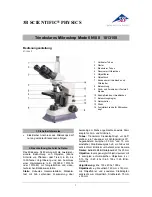
Fluid Operation
Lysozyme on Mica—A Model Procedure for Protein Binding
142
MultiMode SPM Instruction Manual
Rev. B
8.6
Lysozyme on Mica—A Model Procedure for Protein
Binding
8.6.1 Protein Binding Theory
All proteins contain free amino groups that become positively charged at suf
fi
ciently low pH. If
suf
fi
cient free amino groups are located on the outside surface of the protein, then the protein will
bind to a negatively charged mica surface. Proteins will become positively charged at pH below
their isoelectric point and are then able to bind to mica. The protein lysozyme, for example,
becomes suf
fi
ciently positively charged to bind to mica at pH 6. This is shown schematically below
Figure 8.6a
Proteins will typically bind to negatively charged mica when the pH is reduced below the protein’s
isoelectric point, pI
8.6.2 Protein Binding Procedure
The following section gives a detailed procedure for preparing and imaging the protein lysozyme
by TappingMode in
fl
uid. The procedure was kindly provided by Monika Fritz at the University of
California, Santa Barbara and is described in the following paper:
•
Radmacher, M., M. Fritz, H.G. Hansma, P.K. Hansma (1994). “Direct Observation of
Enzyme Activity with Atomic Force Microscopy.”
Science
265
, 1577.
1. Obtain the required materials:
•
Deionized water
•
Mica substrates
•
Lysozyme protein L-6876 from Sigma Chemical
•
Phosphate buffer solution, 10 mM KH
2
PO
4
, 150 mM KCl, pH 6 (buffer may be
adjusted for other proteins)
+ + +
Mica
Buffer
Proteins
pH < pI
+ + +













































